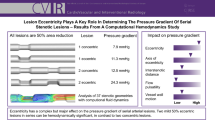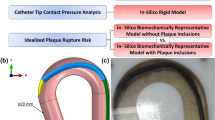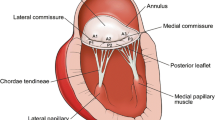Abstract
Purpose
Bicuspid aortic valve (BAV) is a congenital heart malformation with phenotypic heterogeneity. There is no prior computational study that assesses the haemodynamic and valve mechanics associated with BAV type 2 against a healthy tricuspid aortic valve (TAV) and other BAV categories.
Methods
A proof-of-concept study incorporating three-dimensional fluid-structure interaction (FSI) models with idealised geometries (one TAV and six BAVs, namely type 0 with lateral and anterior-posterior orientations, type 1 with R–L, N–R and N–L leaflet fusion and type 2) has been developed. Transient physiological boundary conditions have been applied and simulations were run using an Arbitrary Lagrangian–Eulerian formulation.
Results
Our results showed the presence of abnormal haemodynamics in the aorta and abnormal valve mechanics: type 0 BAVs yielded the best haemodynamical and mechanical outcomes, but cusp stress distribution varied with valve orifice orientation, which can be linked to different cusp calcification location onset; type 1 BAVs gave rise to similar haemodynamics and valve mechanics, regardless of raphe position, but this position altered the location of abnormal haemodynamic features; finally, type 2 BAV constricted the majority of blood flow, exhibiting the most damaging haemodynamic and mechanical repercussions when compared to other BAV phenotypes.
Conclusion
The findings of this proof-of-concept work suggest that there are specific differences across haemodynamics and valve mechanics associated with BAV phenotypes, which may be critical to subsequent processes associated with their pathophysiology processes.









Similar content being viewed by others
References
Akins, C. W., B. Travis, and A. P. Yoganathan. Energy loss for evaluating heart valve performance. J. Thorac. Cardiovasc. Surg. 136(4):820–833, 2008.
Alastruey, J., et al. On the impact of modelling assumptions in multi-scale, subject-specific models of aortic haemodynamics. J. R. Soc. Interface 13(119):20160073, 2016.
Algabri, Y. A., et al. Computational study on hemodynamic changes in patient-specific proximal neck angulation of abdominal aortic aneurysm with time-varying velocity. Australas. Phys. Eng. Sci. Med. 42(1):181–190, 2019.
Bahraseman, H. G., et al. Estimation of maximum intraventricular pressure: a three-dimensional fluid–structure interaction model. Biomed. Eng. Online 12:122, 2013.
Bahraseman, H. G., et al. Effect of exercise on blood flow through the aortic valve: a combined clinical and numerical study. Comput. Methods Biomech. Biomed. Eng. 17(16):1821–1834, 2014.
Bahraseman, H., et al. Combining numerical and clinical methods to assess aortic valve hemodynamics during exercise. Perfusion 29(4):340–350, 2014.
Barker, A. J., C. Lanning, and R. Shandas. Quantification of hemodynamic wall shear stress in patients with bicuspid aortic valve using phase-contrast MRI. Ann. Biomed. Eng. 38(3):788–800, 2010.
Barker, A. J., et al. Bicuspid aortic valve is associated with altered wall shear stress in the ascending aorta. Circ. Cardiovasc. Imaging 5(4):457–466, 2012.
Baumgartner, H., et al. Echocardiographic assessment of valve stenosis: EAE/ASE recommendations for clinical practice. Eur. J. Echocardiogr. 10(1):1–25, 2009.
Becker, W., et al. Bayesian sensitivity analysis of a model of the aortic valve. J. Biomech. 44(8):1499–1506, 2011.
Belytschko, T., J. I. Lin, and C. S. Tsay. Explicit algorithms for the nonlinear dynamics of shells. Comput. Methods Appl. Mech. Eng. 42(2):225–251, 1984.
Bock, J., et al. In vivo noninvasive 4D pressure difference mapping in the human aorta: phantom comparison and application in healthy volunteers and patients. Magn. Reson. Med. 66(4):1079–1088, 2011.
Bonomi, D., et al. Influence of the aortic valve leaflets on the fluid-dynamics in aorta in presence of a normally functioning bicuspid valve. Biomech. Model. Mechanobiol. 14(6):1349–1361, 2015.
Bonow, R. O., et al. ACC/AHA 2006 guidelines for the management of patients with valvular heart disease: a report of the American College of Cardiology/American Heart Association Task Force on Practice Guidelines. J. Am. Coll. Cardiol. 48(3):e1–e148, 2006.
Braunwald, E., and R. O. Bonow. Braunwald’s Heart Disease: A Textbook of Cardiovascular Medicine (9th ed.). Philadelphia: Saunders, 2012.
Burken, J. Determining the Effect of Congenital Bicuspid Aortic Valves on Aortic Dissection Using Computational Fluid Dynamics, in Biomedical Engineering. Iowa City: The University of Iowa, 2012.
Butcher, J. T., and R. M. Nerem. Valvular endothelial cells and the mechanoregulation of valvular pathology. Philos. Trans. R. Soc. Lond. B 362(1484):1445–1457, 2007.
Cao, K., and P. Sucosky. Effect of bicuspid aortic valve cusp fusion on aorta wall shear stress: preliminary computational assessment and implication for aortic dilation. World J. Cardiovasc. Dis. 05(06):129–140, 2015.
Cao, K., and P. Sucosky. Computational comparison of regional stress and deformation characteristics in tricuspid and bicuspid aortic valve leaflets. Int. J. Numer. Method Biomed. Eng. 2017. https://doi.org/10.1002/cnm.2798.
Cao, K., et al. Simulations of morphotype-dependent hemodynamics in non-dilated bicuspid aortic valve aortas. J. Biomech. 50:63–70, 2017.
Carty, G., S. Chatpun, and D. M. Espino. Modeling blood flow through intracranial aneurysms: a comparison of newtonian and non-Newtonian viscosity. J. Med. Biol. Eng. 36(3):396–409, 2016.
Chandra, S., N. M. Rajamannan, and P. Sucosky. Computational assessment of bicuspid aortic valve wall-shear stress: implications for calcific aortic valve disease. Biomech. Model. Mechanobiol. 11(7):1085–1096, 2012.
Chandran, K. B., S. E. Rittgers, and A. P. Yoganathan. Biofluid Mechanics: The Human Circulation. Boca Raton: CRC/Taylor & Francis, 2007.
Chen, Y., and H. X. Luo. A computational study of the three-dimensional fluid–structure interaction of aortic valve. J. Fluids Struct. 80:332–349, 2018.
Choudhury, N., et al. Local mechanical and structural properties of healthy and diseased human ascending aorta tissue. Cardiovasc. Pathol. 18(2):83–91, 2009.
Conti, C. A., et al. Biomechanical implications of the congenital bicuspid aortic valve: a finite element study of aortic root function from in vivo data. J. Thorac. Cardiovasc. Surg. 140(4):890–896, 2010.
Dasi, L. P., et al. Fluid mechanics of artificial heart valves. Clin. Exp. Pharmacol. Physiol. 36(2):225–237, 2009.
De Hart, J., et al. A two-dimensional fluid–structure interaction model of the aortic valve [correction of value]. J. Biomech. 33(9):1079–1088, 2000.
De Hart, J., et al. A three-dimensional computational analysis of fluid-structure interaction in the aortic valve. J. Biomech. 36(1):103–112, 2003.
Dolan, J. M., et al. High fluid shear stress and spatial shear stress gradients affect endothelial proliferation, survival, and alignment. Ann. Biomed. Eng. 39(6):1620–1631, 2011.
Doorly, D., and S. Sherwin. Geometry and flow. In: Cardiovascular Mathematics: Modeling and Simulation of the Circulatory System, edited by L. Formaggia, A. Quarteroni, and A. Venezian. New York: Springer, 2009.
El-Hamamsy, I., A. H. Chester, and M. H. Yacoub. Cellular regulation of the structure and function of aortic valves. J. Adv. Res. 1:5–12, 2010.
Espino, D. M., D. E. Shepherd, and D. W. Hukins. Evaluation of a transient, simultaneous, arbitrary Lagrange-Euler based multi-physics method for simulating the mitral heart valve. Comput. Methods Biomech. Biomed. Eng. 17(4):450–458, 2014.
Espino, D. M., D. E. T. Shepherd, and D. W. L. Hukins. Transient large strain contact modelling: a comparison of contact techniques for simultaneous fluid–structure interaction. Eur. J. Mech. B 51:54–60, 2015.
Faggiano, E., et al. Helical flows and asymmetry of blood jet in dilated ascending aorta with normally functioning bicuspid valve. Biomech. Model. Mechanobiol. 12(4):801–813, 2013.
Ferdous, Z., H. Jo, and R. M. Nerem. Strain magnitude-dependent calcific marker expression in valvular and vascular cells. Cells Tissues Organs 197(5):372–383, 2013.
Formaggia, L., K. Perktold, and A. Quarteroni. Basic mathematical models and motivations. In: Cardiovascular Mathematics: Modeling and Simulation of the Circulatory System, edited by L. Formaggia, A. Quarteroni, and A. Veneziani. New York: Springer, 2009.
Gilmanov, A., and F. Sotiropoulos. Comparative hemodynamics in an aorta with bicuspid and trileaflet valves. Theoret. Comput. Fluid Dyn. 30(1–2):67–85, 2016.
Gode, S., et al. The role of the angle of the ascending aortic curvature on the development of type A aortic dissection: ascending aortic angulation and dissection. Interact. Cardiovasc. Thorac. Surg. 29(4):615–620, 2019.
Goudot, G., et al. Aortic wall elastic properties in case of bicuspid aortic valve. Front. Physiol. 10:299, 2019.
Grimard, B. H., and J. M. Larson. Aortic stenosis: diagnosis and treatment. Am. Fam. Phys. 78(6):717–724, 2008.
Hager, A., et al. Diameters of the thoracic aorta throughout life as measured with helical computed tomography. J. Thorac. Cardiovasc. Surg. 123(6):1060–1066, 2002.
Halevi, R., et al. Fluid–structure interaction modeling of calcific aortic valve disease using patient-specific three-dimensional calcification scans. Med Biol Eng Comput 54(11):1683–1694, 2016.
Hallquist, J. LS-DYNA Keyword User’s Manual. Livermore, USA: Livermore Software Technology Corporation, LSTC, 2006.
Hamatani, Y., et al. Pathological investigation of congenital bicuspid aortic valve stenosis, compared with atherosclerotic tricuspid aortic valve stenosis and congenital bicuspid aortic valve regurgitation. PLoS ONE 11(8):e0160208, 2016.
Heuzé, O. General form of the Mie-Grüneisen equation of state. C.R. Mec. 340:679–687, 2012.
Kim, H. J., et al. On coupling a lumped parameter heart model and a three-dimensional finite element aorta model. Ann. Biomed. Eng. 37(11):2153–2169, 2009.
Kimura, N., et al. Patient-specific assessment of hemodynamics by computational fluid dynamics in patients with bicuspid aortopathy. J. Thorac. Cardiovasc. Surg. 153(4):S52–S62, 2017.
Kouhi, E., and Y. S. Morsi. A parametric study on mathematical formulation and geometrical construction of a stentless aortic heart valve. J. Artif. Organs 16(4):425–442, 2013.
Kuan, M. Y., and D. M. Espino. Systolic fluid–structure interaction model of the congenitally bicuspid aortic valve: assessment of modelling requirements. Comput. Methods Biomech. Biomed. Eng. 18(12):1305–1320, 2015.
Lavon, K., et al. Fluid–structure interaction models of bicuspid aortic valves: the effects of nonfused cusp angles. J. Biomech. Eng. 2018. https://doi.org/10.1115/1.4038329.
Liu, J., J. A. Shar, and P. Sucosky. Wall shear stress directional abnormalities in BAV aortas: toward a new hemodynamic predictor of aortopathy? Front. Physiol. 9:993, 2018.
Lorenz, R., et al. 4D flow magnetic resonance imaging in bicuspid aortic valve disease demonstrates altered distribution of aortic blood flow helicity. Magn. Reson. Med. 71(4):1542–1553, 2014.
Luraghi, G., et al. Does clinical data quality affect fluid–structure interaction simulations of patient-specific stenotic aortic valve models? J. Biomech. 94:202–210, 2019.
Mahadevia, R., et al. Bicuspid aortic cusp fusion morphology alters aortic three-dimensional outflow patterns, wall shear stress, and expression of aortopathy. Circulation 129(6):673–682, 2014.
Manning, W. J. Asymptomatic aortic stenosis in the elderly: a clinical review. JAMA 310(14):1490–1497, 2013.
Markl, M., P. J. Kilner, and T. Ebbers. Comprehensive 4D velocity mapping of the heart and great vessels by cardiovascular magnetic resonance. J. Cardiovasc. Magn. Reson. 13:7, 2011.
Marom, G., et al. Effect of asymmetry on hemodynamics in fluid-structure interaction model of congenital bicuspid aortic valves. Conf. Proc. IEEE Eng. Med. Biol. Soc. 2012:637–640, 2012.
McNally, A., A. Madan, and P. Sucosky. Morphotype-dependent flow characteristics in bicuspid aortic valve ascending aortas: a benchtop particle image velocimetry study. Front Physiol 8:44, 2017.
Mei, S., et al. Hemodynamics through the congenitally bicuspid aortic valve: a computational fluid dynamics comparison of opening orifice area and leaflet orientation. Perfusion 31(8):683–690, 2016.
Metzler, S. A., et al. Cyclic strain regulates pro-inflammatory protein expression in porcine aortic valve endothelial cells. J. Heart Valve Dis. 17(5):571–577, 2008; (discussion 578).
Mirabella, L., et al. MRI-based protocol to characterize the relationship between bicuspid aortic valve morphology and hemodynamics. Ann. Biomed. Eng. 43(8):1815–1827, 2015.
Mohammadi, H., R. Cartier, and R. Mongrain. The impact of the aortic valve impairment on the distant coronary arteries hemodynamics: a fluid–structure interaction study. Med. Biol. Eng. Comput. 55(10):1859–1872, 2017.
Nishimura, R. A., et al. 2014 AHA/ACC guideline for the management of patients with valvular heart disease: a report of the American College of Cardiology/American Heart Association Task Force on Practice Guidelines. J. Am. Coll. Cardiol. 63(22):e57–e185, 2014.
Nistri, S., et al. Aortic elasticity and size in bicuspid aortic valve syndrome. Eur. Heart J. 29(4):472–479, 2008.
Oliveira, D., et al. Bicuspid aortic valve aortopathies: an hemodynamics characterization in dilated aortas. Comput. Methods Biomech. Biomed. Eng. 22(8):815–826, 2019.
Pasta, S., et al. Difference in hemodynamic and wall stress of ascending thoracic aortic aneurysms with bicuspid and tricuspid aortic valve. J. Biomech. 46(10):1729–1738, 2013.
Piatti, F., et al. 4D flow analysis of BAV-related fluid-dynamic alterations: evidences of wall shear stress alterations in absence of clinically-relevant aortic anatomical remodeling. Front. Physiol. 8:441, 2017.
Poullis, M. P., et al. Ascending aortic curvature as an independent risk factor for type A dissection, and ascending aortic aneurysm formation: a mathematical model. Eur. J. Cardiothorac. Surg. 33(6):995–1001, 2008.
Richards, K. E., et al. Influence of structural geometry on the severity of bicuspid aortic stenosis. Am. J. Physiol. Heart Circ. Physiol. 287(3):H1410–H1416, 2004.
Robicsek, F., et al. The congenitally bicuspid aortic valve: how does it function? Why does it fail? Ann. Thorac. Surg. 77(1):177–185, 2004.
Rodriguez-Palomares, J. F., et al. Aortic flow patterns and wall shear stress maps by 4D-flow cardiovascular magnetic resonance in the assessment of aortic dilatation in bicuspid aortic valve disease. J. Cardiovasc. Magn. Reson. 20(1):28, 2018.
Rooprai, J., et al. Thoracic aortic aneurysm growth in bicuspid aortic valve patients: role of aortic stiffness and pulsatile hemodynamics. J. Am. Heart Assoc. 8(8):e010885, 2019.
Saikrishnan, N., et al. In vitro characterization of bicuspid aortic valve hemodynamics using particle image velocimetry. Ann. Biomed. Eng. 40(8):1760–1775, 2012.
Shewchuk, J.R. What is a good linear element? Interpolation, conditioning, and quality measures. in Eleventh International Meshing Roundtable. 2002.
Sievers, H. H., and C. Schmidtke. A classification system for the bicuspid aortic valve from 304 surgical specimens. J. Thorac. Cardiovasc. Surg. 133(5):1226–1233, 2007.
Sievers, H. H., et al. Toward individualized management of the ascending aorta in bicuspid aortic valve surgery: the role of valve phenotype in 1362 patients. J. Thorac. Cardiovasc. Surg. 148(5):2072–2080, 2014.
Simão, M., et al. Aorta ascending aneurysm analysis using CFD models towards possible anomalies. Fluids 2(2):31, 2017.
Spuhler, J. H., et al. 3D fluid–structure interaction simulation of aortic valves using a unified continuum ALE FEM model. Front. Physiol. 9:363, 2018.
Sturla, F., et al. Impact of modeling fluid-structure interaction in the computational analysis of aortic root biomechanics. Med. Eng. Phys. 35(12):1721–1730, 2013.
van Loon, R., et al. Comparison of various fluid–structure interaction methods for deformable bodies. Comput. Struct. 85(11–14):833–843, 2007.
Vergara, C., et al. Influence of bicuspid valve geometry on ascending aortic fluid dynamics: a parametric study. Artif. Organs 36(4):368–378, 2012.
Viscardi, F., et al. Comparative finite element model analysis of ascending aortic flow in bicuspid and tricuspid aortic valve. Artif. Organs 34(12):1114–1120, 2010.
Wang, S. H., L. P. Lee, and J. S. Lee. A linear relation between the compressibility and density of blood. J. Acoust. Soc. Am. 109(1):390–396, 2001.
Ward, C. Clinical significance of the bicuspid aortic valve. Heart 83(1):81–85, 2000.
Wu, W., et al. Fluid–structure interaction model of a percutaneous aortic valve: comparison with an in vitro test and feasibility study in a patient-specific case. Ann. Biomed. Eng. 44(2):590–603, 2016.
Yap, C. H., N. Saikrishnan, and A. P. Yoganathan. Experimental measurement of dynamic fluid shear stress on the ventricular surface of the aortic valve leaflet. Biomech. Model. Mechanobiol. 11(1–2):231–244, 2012.
Acknowledgments
The authors wish to thank ARUP for providing the LS-DYNA and LS-PrePost licenses for version R7.1.2.
Funding
No relevant funding.
Conflict of interest
The authors declare that they have no competing interests.
Statement Involving Human and ANIMAL Rights
No human or animal studies were carried out by the authors for this article.
Author information
Authors and Affiliations
Corresponding author
Additional information
Associate Editor David Steinman oversaw the review of this article.
Publisher's Note
Springer Nature remains neutral with regard to jurisdictional claims in published maps and institutional affiliations.
Electronic Supplementary Material
Below is the link to the electronic supplementary material.
Rights and permissions
About this article
Cite this article
de Oliveira, D.M.C., Abdullah, N., Green, N.C. et al. Biomechanical Assessment of Bicuspid Aortic Valve Phenotypes: A Fluid–Structure Interaction Modelling Approach. Cardiovasc Eng Tech 11, 431–447 (2020). https://doi.org/10.1007/s13239-020-00469-9
Received:
Accepted:
Published:
Issue Date:
DOI: https://doi.org/10.1007/s13239-020-00469-9




